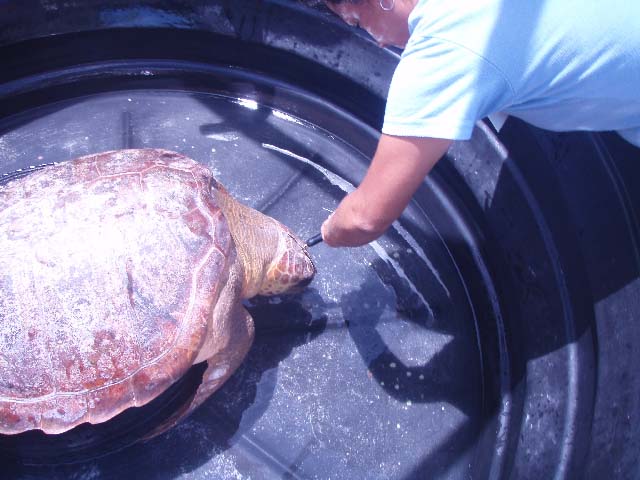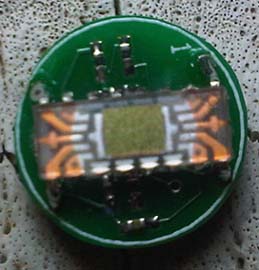
|
Sea Turtle Acupuncture Resuscitation Pilot Trial and the Tortuga Revival DeviceBy Steve Canion D.C., C.Ac, Biologist and Phil Rogers MVB, MRCVSScientific AbstractA turtle found stranded or caught in a net may appear to be dead, in a coma, or in shock; having lost or suppressed reflexes and showing no signs of breathing. Most turtles caught by shrimp trawlers, under conditions of forced submergence, are not drowned but in a coma. (ref.1 The decline of the Sea Turtle 1990. A 1989 study by National Marine Fisheries Service of 7 research projects spanning 12 years during which 4,397 turtles were caught in trawler nets found that for most tow times, there were more comatose than drowned turtles.) Although a comatose turtle may revive on its own after several hours on land/boat, the fate of a comatose turtle returned directly to the sea is unknown. It is reasonable to assume that they will die. (Kemmerer 1989) Applying the Acupuncture Protocol for Sea Turtle Resuscitation should revive the turtle in 30 seconds to 10 minutes, depending on the circumstances of the individual trauma. The Sea Turtle Acupuncture Resuscitation protocol can be performed anywhere in the world; in the laboratory, in the field, or on a shrimp trawler. We are currently looking for scientists, biologists, veterinarians, and sea turtle researchers to share this protocol with those who would have access to sea turtles in shock, coma, cardiac distress or otherwise “dead” appearing turtles. (A turtle may appear to be dead when in shock or coma, having lost or suppressed reflexes and showing no signs of breathing.) A published bibliography of 138 books/clinical trials by Phil Rogers D.V.M. documents the effects and clinical efficacy of stimulation of acupoint GV26 in humans and animals.
For further information on the work of Dr. Phil Rogers in veterinary acumpucture, please click here GV26 is the most used emergency point in acupuncture. Stimulation of GV26 resuscitated to consciousness humans and animals (some that were pronounced clinically dead) in acute emergencies, narcosis and shock. It had potent anti-shock effects and decreased mortality rates in haemorrhagic, surgical, post partum, endotoxic, anaphylactic, and other forms of shock. It countered exhaustion, enhanced hepatic metabolism and adrenocortical function, promoted membrane transport, and helped recovery in prostration. It regulated the central nervous system and had anti-convulsive effects and reversed the depressive effects of general anaesthesia on the central nervous-, autonomic-, cardiovascular-, and respiratory systems. It enhanced cardiovascular and cerebrovascular function: it enhanced heart function, had sympathomimetic (cardiostimulant) effects on the cardiovascular system, had pressor effects in haemorrhagic shock and ischemic hypotensiuon. It was effective in acute brain and cerebral emergencies and in treating their sequels. It enhanced brain perfusion and hastened clinical recovery after cerebrovascular accident. It enhanced brain perfusion and hastened clinical recovery after cerebrovascular accident. It enhanced respiratory functions and reversed neonatal and anaesthetic apnoea, increased neuronal activity in the respiratory center and increased amplitude of phrenic nerve discharges. Four additional acupuncture points are also suggested for drowned or comatose turtles; cardioactive points PC6 and PC9 and points used for revival from drowning, K1 and tail tip point. These points were extrapolated to the sea turtle from humans and other animals based on the underlying anatomy and physiological structure/function.
My fellow researcher on the protocol, Phil Rogers D.V.M. and Veterinary Acupuncturist, has published extensively on these points and has used them to revive animals. The procedure for using these points is easy for anyone to learn. For Phil Rogers' published review of the use of GV26 in resuscitation of animals click here. Dr. Rogers states: Though several Chinese reports on humans and animals, and a few papers by Lee's team in USA on experimental shock in dogs, had published very significant effects of GV26 on respiratory and cardiovascular responses in the early 1970s, I was probably the first scientist to publish the use of GV26 in emergencies in a western veterinary journal. I used it in a rat that stopped breathing after a 3-hour experimental brain-surgery in the Agric Fac Neurophysiology Unit of Wageningen University. The surgeons tried conventional resuscitation (chest massage, positive bulb ventilation and, I think, millophyline injection) but their attempts failed and they gave up (because another rat was in mid-operation and they had to continue operating on that rat). Without asking permission, I used a brain electrode to stimulate GV26. It worked in seconds and the rat survived. The philtrum point VG26 (Renzhong, Jen Chung, GV26) was needled in 69 cases of respiratory depression or apnea in dogs and cats during induction or maintenance of general anesthesia. Respiration was restored to normal or near normal rates within 10 to 30 seconds of insertion of the needle in all cases. In 7 cases of anesthetic apnea with concurrent cardiac arrest and absence of vital signs, the revival rate was 43%. Those which recovered required 4-10 minutes of acupuncture stimulation. In 8 cases of collapse due to other causes, the revival rate was 25%. The cases included five sheep in [hemorrhagic] shock following liver biopsy, two cases of hemorrhagic shock (dog, cat), and one terminal collapse in chronic congestive heart failure (dog). From our results in dogs (the 1980 paper above), for sea turtles my gut predicts 80% success of cases whose hearts are beating at the start of the intervention, and 50 to 20% success in cases whose hearts have stopped 1-10 minutes before the intervention. See: Rogers PAM (1977) Revival in collapse, shock, respiratory failure and narcotic overdose. Veterinary Record, vol. 101, no. 11, p. 215, 6 ref., ISSN: 0042-4900. See also: Janssens L, Altman S & Rogers PAM (1979) Respiratory and cardiac arrest under general anaesthesia: treatment by acupuncture of the nasal philtrum. Veterinary Record, vol. 105, no. 12, p. 273-276, 32 ref., ISSN: 0042-4900. ResultsResults of Sea Turtle Acupuncture Pilot Trial Is it possible to revive stranded dead appearing sea turtles, turtles in coma from head injuries, or ones that have recently drowned? The answer is yes. The question is when to attempt to revive them. If they are stranded, there is probably some underlying pathology that you should be prepared to treat after you revive them. At Australian Seabird Rescue, their results were five revived out of fourteen attempts, and one survived long term and was released. These were turtles otherwise declared dead. At South Carolina Aquarium, acupuncture and epi and doxapram were used to temporarily revive a few loggerheads that were declared dead. At Xcaret, Mexico, two loggerheads have been revived long term after head injuries. The first, on i.v. over three months, not eating or diving - just floating. She began moving during the first treatment and within a week began eating; over a few weeks diving and acting like a normal turtle. The second loggerhead responded to acupuncture, beginning with slow reactions and made good progress. At LeReunion France, two loggerheads were resuscitated successfully and released after being submerged, caught by a hook. Pilot results thus far have had a 25 percent revival rate (short term) for beached dead turtles, a 100 percent revival rate for coma from concussion ,and a 100 % revival rate after coma from forced submergence. The positive results of the small trial (sixteen turtles) suggests the need for a larger full scale controlled trial. Shrimp trawling is one of the greatest causes of sea turtle mortality throughout the world. The S.T.A.R.. protocol was originally designed by Phil Rogers M.S.R.V.C. and myself to revive turtles in shock/coma for only a few hours due to being submerged by trawler nets or longline fishermen. Acupuncture at a 1-3 specific points has been used by clinicians to successfully revive comatose humans, horses, dogs, cats and other species. National Marine Fisheries Service compiled the results of seven research projects spanning twelve years during which 4,397 turtles were caught in trawler nets. For most tow times, there were more comatose than dead turtles. Given the feedback regarding training laymen to use needles to resuscitate sea turtles aboard trawlers, a dime sized solar powered 10hz microamp generator has been developed by myself and Joe Randolph of Randolph Telecom. It is working in human trials and rapidly having the desired physiologic effect when used at acupuncture points. This device would be placed just below the turtle's nostrils at the philtrium - the main sea turtle emergency point. As easy as putting on a bandaid. Human testing began in early October 2009. We have had a 100 percent success rate and results that outperform our clinical microcurrent stimulators. We are now selecting veterinarians to perform the first sea turtle trials and will have results to report by the symposium date in April 2009. CLICK HERE TO SAVE OR PRINT THE S.T.A.R. RESULTS FORM CLICK HERE TO SAVE OR PRINT THE S.T.A.R. PROTOCOL Copyright 2014 Dr. Steve's Health Center. All rights reserved. |



